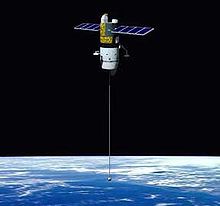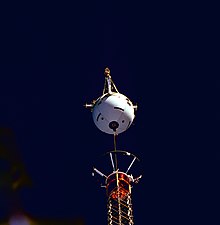Space tether
A space tether (from English space , "space" and tether , "leash", "tension rope", "fetter") is a long, strong rope that holds spacecraft together in groups and, according to a scientific proposal, to change the orbit to save fuel can be used by spacecraft and to generate electrical energy. In the 1970s and early 1980s, Giuseppe Colombo , professor at the University of Padua (Italy), presented studies that showed the possibilities of space tether.
High- strength materials are required for production ; experiments are currently being carried out with the Dyneema polyethylene fiber , and carbon nanotubes are to be used in the future.
Colombo - Orbit Changes and Electrical Effects
A missile is at a constant orbit around a planet or a sun, so there is a balance between the gravity (gravity), which attracts the missile towards the center of mass of the object around which it revolves and the centrifugal force , represented by the circumnavigation arises in orbit at a certain speed. Gravitation decreases quadratically with the distance between the missile and (center of the) planet.
The so-called tidal force now acts on extended bodies , because the force on the side facing the gravitational partner is stronger than that on the side facing away from the gravitational partner. If two missiles are connected in different orbits by a tether, they can be understood as an extended object. The tidal force now creates tension on the rope, as the missile in the lower orbit has a higher attraction than the one in the higher one.
If two objects are on different orbits over a planet, the higher-flying body has a slower speed than the lower-flying one in order to maintain the balance between gravity and centrifugal force. If the two missiles are now connected with a tether, the rope is tensioned by this speed difference. The originally faster partner is slowed down and the originally slower partner is accelerated, thereby both move through the connection with the same angular speed on different orbits.
If a space shuttle has the task of releasing a satellite, it could abseil it via a space tether. The satellite would be lowered into a higher orbit than the one on which the orbiter is located. The space shuttle and satellite moved in different orbits at the same speed, whereby, as described, the satellite of the higher orbit moved faster than necessary, the shuttle slower. If the connection were cut in this state, the satellite would fly freely into a higher orbit, since the speed given by the tether is too high for the current orbit. The space shuttle would be too slow for its orbit and would return to the planet.
Colombo suggested that tethers could also be used to generate electrical energy: when an electrical conductor is moved through a magnetic field, voltage is induced in it. Thus, a satellite that spreads long tethers could supply itself with energy. The usefulness of this effect is limited by the fact that the conductor in which the voltage is induced itself generates a field opposite to the earth's magnetic field. This slows down the entire spacecraft and tether system ( Lenz's rule ).
Correspondingly, a tether through which a strong current flows could also contribute to a change in the position or orbit of a satellite, since a force acts on a current-carrying conductor in the magnetic field ( Lorentz force ). Studies show that such electrical tethers (English electrodynamic tethers ) could be effective despite only slow orbital changes due to the fuel saving .
Research projects and experiments on the topic
The idea of using tethers to connect spaceships goes back to the early days of space travel. In 1966 was at manned program Gemini the NASA the Gemini capsule 11 coupled to the stage rocket Agena. The astronauts released the coupling again and only remained connected with a safety rope. Through control maneuvers, they were able to generate a rotation of the coupled objects around the common center of gravity, so that they actually (even if imperceptibly) created artificial gravity . The experiment was repeated with Gemini 12 .
In 1992 and 1996 NASA flew the shuttle missions STS-46 and STS-75 , whose tasks included testing the “Tethered Satellite Systems” (TSS) of the Italian Space Agency (ASI). The TSS was a 550 kg spacecraft that was to be rappelled down a 20 km long tether. The purpose of the experiment was to test the generation of electricity. The attempt in 1992 failed, but in 1996 it was possible to demonstrate the creation of a voltage of 3500 volts with currents at the ampere level. The mission ended with a technical failure of the insulation of the tether, but it was still considered a success: In addition to the proof of the electrical effect, it was now known that the electrical output was twice as high as previously assumed. Furthermore, after separating the tether, the satellite was launched into orbit, 140 km above that of the shuttle, which demonstrated the effect of the orbit change by tether.
In September 2007 a 30 km long tether was tested on board a Russian Foton M3 research satellite as part of the YES2 project ( Young Engineers Satellite ), which was carried out almost exclusively by students and young engineers, with which the probe deployed on the tether was tested Fotino was put on a re-entry track.
On January 23, 2009, the Japanese space agency JAXA started the Space Tethered Autonomous Robotic Satellite (STARS) developed by the Kagawa Satellite Development Project at the University of Kagawa , with which the use of tether systems for future propulsion systems should be tested. The Tether Electrodynamics Propulsion CubeSat Experiment (TEPCE) of the US Naval Research Laboratory, launched in June 2019 with the STP-2 mission, serves the same purpose . This is a Cubesat pair that is connected with a 1 km long cord. Electric currents through the cord should enable navigation in the earth's magnetic field by means of the induced magnetic field .
See also
Web links
- Greg Goebel: Spaceflight Propulsion (English)
- Space Tethers nasa.gov, accessed March 30, 2011
- Tethers Unlimited Incorporated (English)
- NASA IAC report on orbital systems (English; PDF file; 2.24 MB)
- Short story with tethers ( Memento from December 8, 2010 in the Internet Archive )
- Young Engineers' Satellite 2
Individual evidence
- ↑ YES2 given green light for launch
- ↑ Kagawa satellite development project STARS, developed at the University of Kagawa ( Memento from February 1, 2009 in the Internet Archive )
- ↑ Donna McKinney: NRL's TEPCE Spacecraft Undergoes Successful Deployment Test. May 18, 2010, accessed April 23, 2019 .



